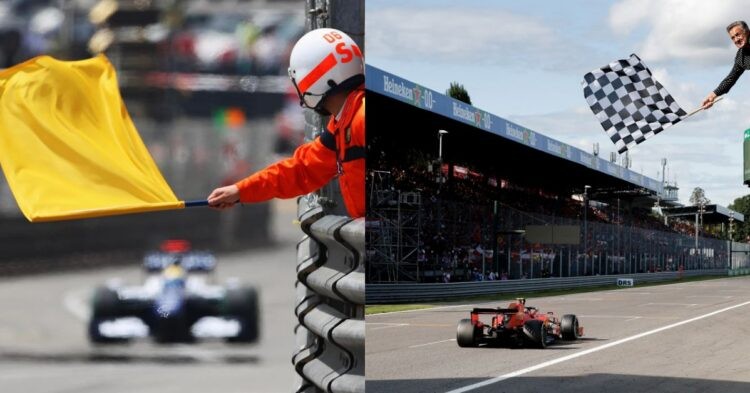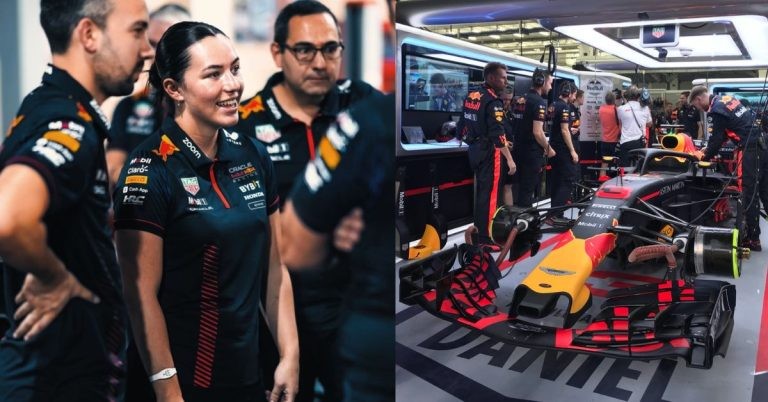Formula 1 is a fast-paced motorsport that uses types of flags to communicate with drivers during competition. The Fédération Internationale de l’Automobile, also known as the FIA, oversees Formula 1 racing. They are in charge of upholding all of the sport’s rules and regulations, including the use of flags.
On the track, flags are essential for drivers since they assist make a situation obvious, whether it’s an instruction to a driver, a hazard warning, letting them know the state of the track, or telling them the status of the session they are racing in.
The incident that brought out red flags in Imola 🚩#ImolaGP 🇮🇹 #F1 pic.twitter.com/Z18dCPXwOZ
— Formula 1 (@F1) April 18, 2021
There are several distinct flags used in Formula 1, each with a unique meaning, and some are used more frequently than others. The many Formula 1 flags and the signals they convey will be covered in this guide.
Yellow flag
The yellow flag is one flag that is most frequently used during Formula 1 races. This flag is used to alert drivers to dangers that may be found on or around the track.
If one or two yellow flags are raised, however, it influences how the flag is understood. Drivers should slow down, avoid overtaking and be ready to change lanes if there is only one yellow flag. This is due to danger that might be present on the track. There might be a fine on the driver if they cannot demonstrate that they passed the area where the yellow flag is being waved at a slower pace.
Yellow and red flag
The yellow and red flag signals an impending change in the track surface. Typically, it informs the driver that there may be water or oil on the track ahead of the flag, which could reduce grip and increase the chances that they will lose control of the vehicle if they go without caution.
Red flag
The red flag is another common flag used in Formula 1. Drivers are required to scale back their pace and return to the pit lane when the session is interrupted by a red flag. The session will resume with the drivers in the order they were in when the red flag was displayed.
Overtaking is strictly forbidden. On their approach back to the pits, drivers are advised to use caution because the track could be blocked and service trucks could be present. If the track is not safe for the session to continue, the weather can also raise a red flag.
🚩 RED FLAG 🚩
— Formula 1 (@F1) March 4, 2023
The Q1 action is halted after just a few minutes
Charles Leclerc’s first timed lap doesn’t go to plan, with two small pieces of bodywork coming off his car#BahrainGP #F1 pic.twitter.com/A2RLui0l2X
At the Saudi Arabia Grand Prix of 2021, two red flags were raised, firstly when Max Verstappen crashed into a wall followed by a subsequent crash by the then-new driver at Haas, Mick Schumacher.
Green flag
The first flag raised during an F1 race is the green flag. It indicates the beginning of the race or its resumption following a safety car or red flag phase. Drivers are free to begin racing at full speed once the green flag is raised. Moreover, the conclusion of a caution period or pit stop window is signaled with this flag.
Blue flag
When a driver is about to lap, they will be given the blue flag, instructing them to let the approaching car through as soon as possible, when a driver is ready to lap them in a race, meaning their pace advantage has seen them finish a full lap more. A driver runs the risk of being fined if they disregard three blue flags in a row.
Black flag
One of Formula 1’s worst penalties is the black flag. It is used to indicate that a driver has been disqualified from the race or must head back to the pits right away because of a technical issue or risky maneuver. The black flag may occasionally be used to indicate that a driver disregarded prior warnings, as when they were issued for persistently violating the white line during pit entry.
Know your flags! A pre-race run down of all things red, yellow and chequered 🏁👉https://t.co/gFpzgGiAZY #F1 pic.twitter.com/Ahz8MwP7xy
— Oracle Red Bull Racing (@redbullracing) April 3, 2016
The 7X WDC legend, Michael Schumacher once received the black flag during the British Grand Prix of 1994. He received a stop-go penalty and failed to serve it within the given time and was shown the black flag twice during the course of the race.
Black and orange flag
The black and orange flag, which has an orange central disc on a black background, is displayed to advise a driver to enter the pit lane on the following lap when their car is experiencing a mechanical issue that could put them or others in danger. The driver’s license number will be included with the flag as identification.
The driver may return to the track if the team can successfully resolve that problem.
LAP 37/51
— Formula 1 (@F1) June 12, 2022
Tsunoda has rear wing issues and has been shown a black and orange flag by race stewards, which means he’ll have to pit for repairs#AzerbaijanGP #F1 pic.twitter.com/RVJ58oM0o3
White flag
The presence of a parked vehicle on the track is indicated by the white flag. This car can be a safety vehicle, a medical vehicle, or one that has mechanical problems. Drivers must slow down and be ready to stop if necessary when the white flag is waved.
Black and white flag
The black and white sections of this flag are separated diagonally by the design. When a driver is being warned for acting in an unsportsmanlike manner, the flag is held still and the driver’s number is displayed to identify the offender. When a driver sees the black and white flag, if they don’t respond differently, the subsequent level of action is a penalty.
Chequered flag
Of all the flags used in Formula 1, the checkered flag is the most recognizable one. When the chequered flag is raised, the race has ended, and the winner is the first driver to cross the line. The chequered flag is also raised to indicate the conclusion of practice and qualifying sessions.










